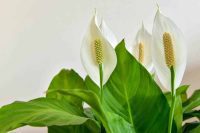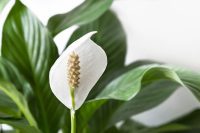At a glance
| Family | Araceae |
| Botanical name | Spathiphyllum spp. |
| Common names | Peace lily, White flag, Cupido peace lily, White peace lily, Espatifilo, Mauna Loa, Snowflower |
| Lifespan | Perennial |
| Habitat | Tropical rainforests |
| Growth habit | Clumping |
| Mature height | 30 – 120 cm |
| Flower colour |
White, green |
| Leaf colour |
Green, variegated |
| Native to | Americas and Southeast Asia |
| Toxicity | Toxic to cats and dogs |
| Soil | Moisture-retaining |
| Humidity | High |
| Propagation | Division |
| Care level | Easy |
What is peace lily?
Peace lily (Spathiphyllum spp.) is a genus of 41 species of perennial herbs native to the tropical rainforests of Southeast Asia and the Americas. This plant is widely favoured as a classic houseplant due to its lush, narrow to elliptic foliage, showy flowers and low maintenance. Peace lilies can be grown outside in temperate and tropical regions.
Although commonly referred to as the ‘peace lily,’ this plant is not, in fact, a true lily. Rather, it is a member of the Araceae family, which encompasses a variety of species, including Monstera, Philodendron, Dieffenbachia, Caladium, Pothos, Anthurium, and Alocasia.
The botanical name Spathiphyllum comes from the Greek words spath (spoon) and phyllon (leaf), which refers to the spoon-shaped flower which sits high on a long stalk.
Description
Leaves
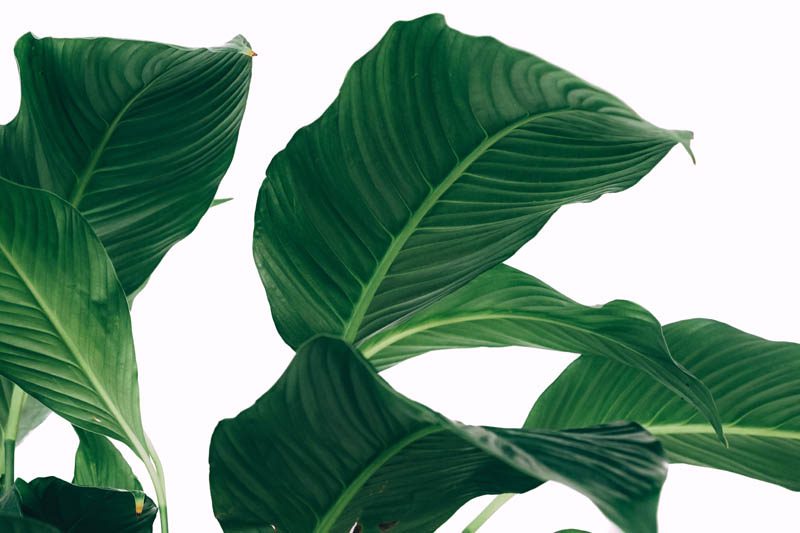
The slender elongated stems of the peace lily support narrow to broad glossy leaves that feature veins running from the midrib to the margins. The leaf color can vary from light to dark green or have a variegated appearance. The size of the plant can vary depending on the species or cultivar, with larger peace lilies growing as tall as 120 cm, while smaller cultivars typically reach a maximum height of 40 cm.
Flowers

The long-lasting flowers grow on a long stalk with a central spadix (small flowers closely arranged around a fleshy axis) and are enveloped by a spathe.
Cultivars
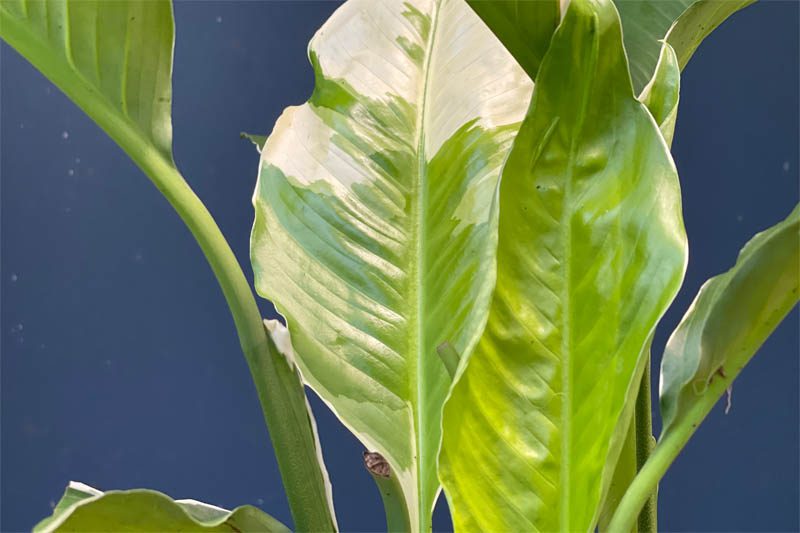
- Picasso: A stunning variegated peace lily has large, green leaves with large areas of white, reminiscent of an artist’s brush strokes
- Mauna Loa Supreme: Large, bold, elliptical leaves on 30 cm stems
- Little angel: A dwarf peace lily that is said to be easier to grow than other cultivars, and flowers more readily
- Piccolino: A compact, dwarf peace lily
- Benito: A bushy, mid-sized peace lily
- Power petite: One of the smallest peace lily cultivars with light green leaves and long-lasting white flowers
- Domino: Variegated peace lily with dark green, narrow leaves sprinkled with white speckles
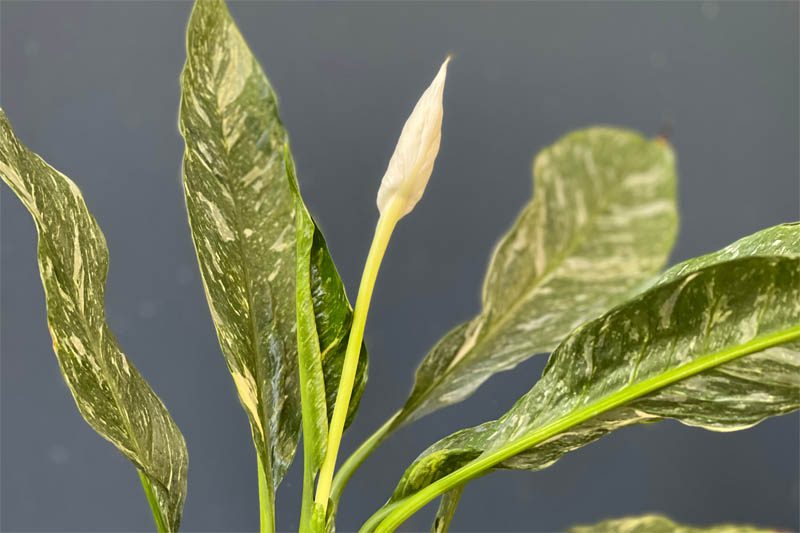
Sensation: The largest Spathiphyllum cultivar, Spathiphyllum ‘Sensation’ has large, deeply ribbed leaves, and can grow to a height of 150 cm.

Care
Peace lily is a relatively easy plant to care for as long as its water requirements are met. The hardest aspect of caring for a peace lily is providing the right amount of water. Unfortunately, wilting leaves can be a sign of under or overwatering. An overwatered peace lily is at risk of root rot. You will know that overwatering is the problem if the plant doesn’t perk up after it has been watered. In this case, remove the plant from the pot, carefully rinse the roots with tepid water, and check for signs of root rot.
Heat can also cause drooping in peace lilies, especially during the summer months. If you are not over or underwatering your peace lily, move it to a shadier location and see if that resolves the problem.
Light |
Bright/indirect light to full shade. Keep out of direct sun to prevent burning the leaves. Protect from wind and draughts. Outdoor plants grow best in part to full shade, facing the morning sun which is less harsh than the afternoon sun.
Definitions:
|
Temperature |
12 to 30°C (53 – 86°F) |
Watering |
Peace lilies like consistently moist soil, but be careful not to saturate it. As water becomes saturated it compacts, and air pockets surrounding the roots are lost, which deprives them of oxygen. Water when the top 2.5 cm (1 inch) of soil has dried. Do not allow the plant to sit in water. If possible, use room-temperature water.
Water less during the winter months when growth has slowed down. Increase once new leaves appear in spring. Once established, peace lilies can tolerate short bouts of dry soil, but should not be left for extended periods to avoid. |
Humidity |
50 percent or higher, mist daily to maintain humidity. |
Soil |
The ideal soil for peace lily is organically-rich, moisture-retaining loamy soil with good aeration and drainage. |
pH |
5.8 to 6.5. |
Fertilising |
Fertilise every 4 weeks with an evenly-based fertiliser with a 20:20:20 NPK ratio, dilute to 1/3 strength. |
Note: I have a number of peace lilies in several locations with different levels of light. The majority live outside (in temperate Sydney), in an east-facing position, with a large tree overhead that blocks out a lot of sunlight. Two peace lilies live in bedrooms, in a west-facing position and positioned several feet away from the window. The indoor plants receive more light than the outdoor ones, but none of them is in direct sun.
Pests and diseases
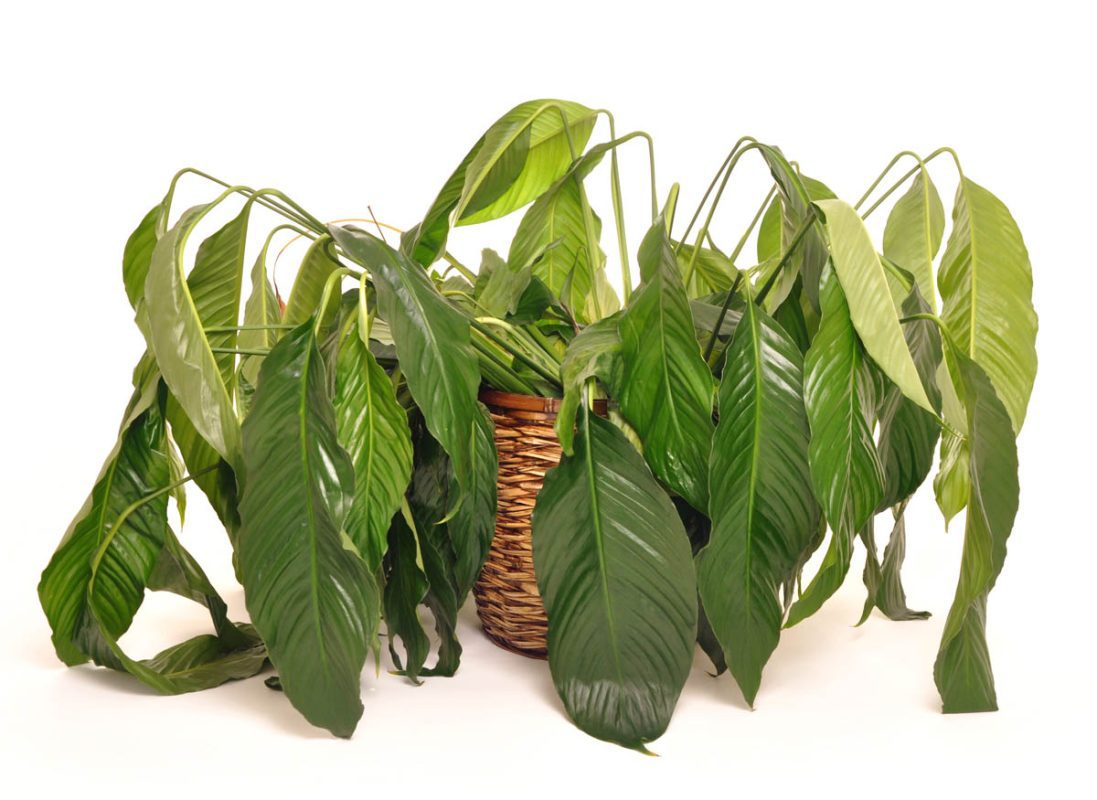
Mealybugs: Insects in the family Pseudococcidae with white filaments extending from the edges of their body. Mealybugs thrive in moist and warm environments, feeding off the sap of the plants they infect. Common signs include yellow leaves, loss of vigour and eventual death. A neem-based oil will kill mealy bugs.
Root rot: There are two common causes of root rot, which are both made worse with overwatering. Bacterial, fungal or water mould root rot is caused by a number of pathogens that invade feeder roots.
Bacteria, fungi and water moulds are everywhere, many of which are beneficial to plants and live in a symbiotic relationship. However, pathogenic bacteria, fungi and water moulds can become dominant strains under the right conditions. Wet soil and humidity provide the perfect environment for these pathogens to multiply.
Anoxic or hypoxic conditions occur when the soil is constantly wet, resulting in compaction. When the soil compacts, pores (air pockets) in the soil, collapse and the roots are starved of oxygen.

Fungus gnats: Small flies of lower Diptera (fly) that are made up of several genera belonging to the Sciaroidea family. Fungus gnats are one of the most common indoor pests and are attracted to moisture and organic matter in household plants. Sticky traps can trap fungus gnats, however, they are only effective against adult mites. I have found leca balls on top of the potting mix deter fungus mites, unfortunately, it makes it more difficult to check soil moisture levels.
Uses
Peace lily makes a low-maintenance and attractive foliage plant for indoors and will tolerate dark corners better than most other houseplants. In temperate and tropical regions they also make an exceptional feature plant when or as a ground cover in shaded borders. Peace lily are also grown in indoor commercial settings such as large atriums, shopping centres (malls) or foyers.
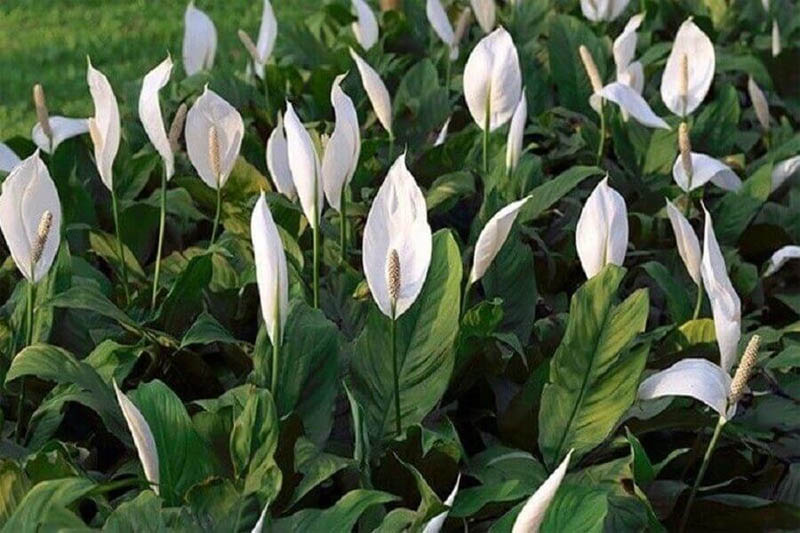
Propagation
Peace lily grows in clumps, mature plants can be easily divided by removing the plant from the pot, and gently teasing the clumps apart. Water in well, but do not apply fertiliser until the roots are well established.
The image below shows where the clumps will be divided. To do this, gently tease apart the clumps, being careful not to damage the roots.
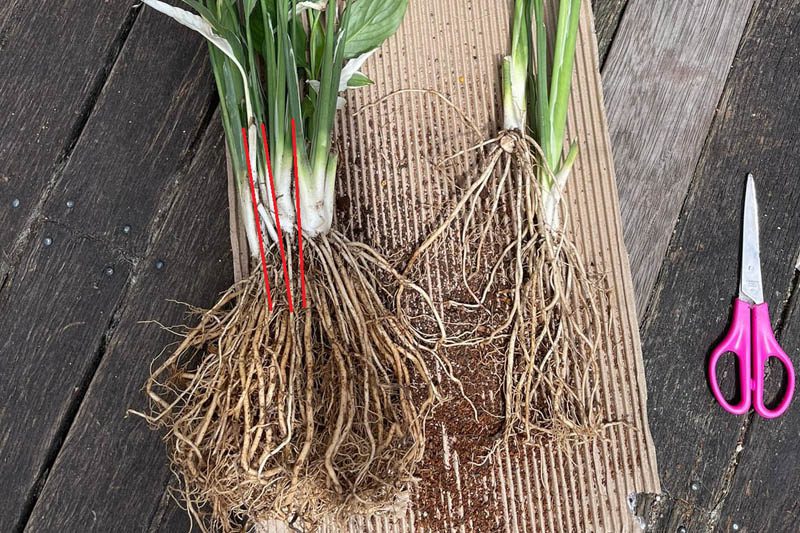

Transplant shock
From personal experience, peace lilies can go into transplant shock after they have been divided. Transplant shock can be caused by damage to the roots or incorrect watering. Signs include wilted and yellowed/brown leaves which can eventually turn black, the roots are prone to root rot, which ultimately kills the plant.
When I experienced transplant shock with my large Picasso peace lily, I removed the plant from its pot, cut off any black roots with sterile scissors, divided it up into several smaller plants and planted each one in its own pot with fresh potting mix. Do not reuse the old potting mix.
Dividing a clumping plant inevitably damages some of the roots, which will shock the plant. The roots on these three divisions are healthy (roots should be creamy white), but the plants on the left and right don’t have much of a root system yet. Roots are responsible for the uptake of water and nutrients for the entire plant, as the plants don’t have a great root system yet, they will struggle to take up enough water and nutrients to support the plant. By leaving only half a leaf for photosynthesis, the plant can focus on developing a root system. The black surrounding the roots is the remains of the sheath, from which the new leaf emerges.
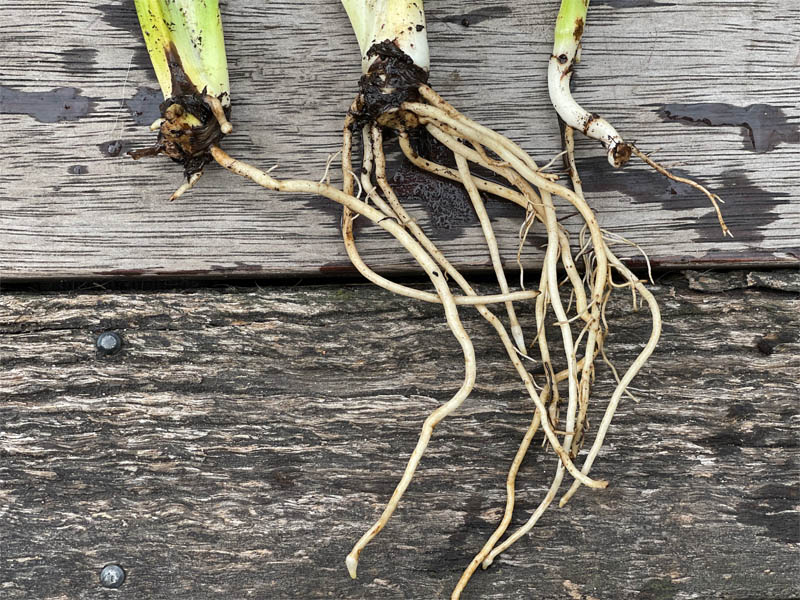
All leaves apart from one were cut off at the base of the stem (near the crown), and the remaining leaf was cut in half to reduce transpiration (water loss through the leaf). The plants received a small amount of water every second day, but no fertiliser. 4 – 6 weeks later, all plants were showing signs of recovery with new growth.
Repotting
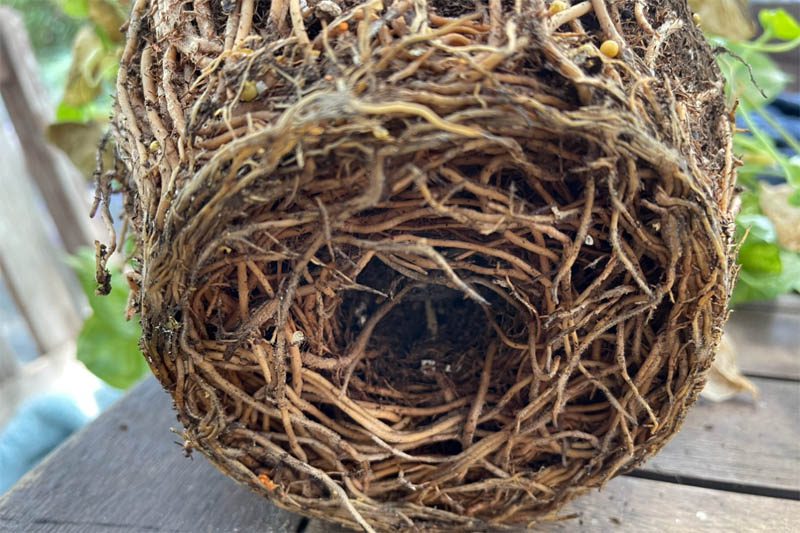
Peace lilies prefer to be slightly root bound, but if the roots are growing out of the drainage holes, growth has slowed down, or the soil dries out faster than expected, it is time to move it to a larger pot. Do not go up more than one pot size (2.5 cm or 1 inch) at a time, as overpotting can lead to root rot.
- Carefully remove the plant from its pot and tease apart the roots.
- Fill 1/4 of the pot with fresh, premium-grade potting mix.
- Place the plant into the pot.
- Add more potting mix until the pot is full.
Is peace lily toxic to pets?
Peace lily is mildly toxic to pets and humans. The toxic principle is needle-sharp insoluble calcium oxalate crystals known as ‘raphides’, which are present in all parts of the plant. When the plant is damaged, raphides are ejected from the plant tissue causing pain, burning and in some cases swelling of the mouth and throat. If your pet chews any part of peace lily, remove any remaining plant matter from the pet’s mouth and offer it a drink of something tasty such as milk or tuna juice. Contact your veterinarian if your pet develops gastrointestinal signs (vomiting, diarrhea, loss of appetite), or develops difficulty breathing.
Julia is a writer and landscape consultant from Wollongong with a love of horticulture. She had been an avid gardener for over 30 years, collects rare variegated plants and is a home orchardist. Julia is passionate about learning and sharing her knowledge of plant propagation and plant toxicology. Whether it’s giving advice on landscape projects or sharing tips on growing, Julia enjoys helping people make their gardens flourish.

